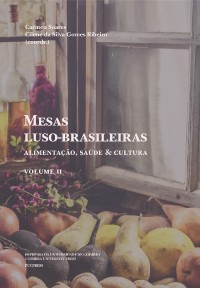Please use this identifier to cite or link to this item:
https://hdl.handle.net/10316.2/45244| DC Field | Value | Language |
|---|---|---|
| dc.contributor.author | Laurioux, Bruno | |
| dc.date.accessioned | 2019-01-30T10:05:54Z | |
| dc.date.accessioned | 2020-09-04T21:27:54Z | - |
| dc.date.available | 2019-01-30T10:05:54Z | |
| dc.date.available | 2020-09-04T21:27:54Z | - |
| dc.date.issued | 2018 | - |
| dc.identifier.isbn | 978-989-26-1719-0 | |
| dc.identifier.isbn | 978-989-26-1720-6 (PDF) | |
| dc.identifier.issn | 2183-6523 | |
| dc.identifier.uri | https://hdl.handle.net/10316.2/45244 | - |
| dc.description.abstract | In the last decades, western European cuisine has undergone very spectacular changes. Among them, a “molecular cuisine” has developed a strong interest for the chemical mechanisms of the cooking process. This is not the first time in the history that cookery has tried to appear as a science: the tension between art and science, innovation and reproduction goes back as far as the Antiquity. This paper studies, from the Vth century BC onward, the cultural framework in which cookery was thought, explaining its classification as an art or a science. The first point is Greek Antiquity, with the question: “Can cookery be written, as other kinds of knowledge?” The Late Middle Ages is the second stage of our history. Scholars of this time raised the following matter: “Is cookery a part of a mechanical art or a mechanical art per se? Next point will be the Renaissance: “Did the rediscovery of Apicius’ book help to define cuisine as an art in the context of the emergence of the fine arts?” Around 1730-1740, a first French “nouvelle cuisine” claimed the status of science, defining itself as a “kind of chemistry”. Throughout the 19th and 20th centuries, two opposite traditions appear: one that stresses the link between cuisine and such fine arts as architecture (Carême), another one that insists on the “scientific” part of cookery. Nowadays, everyone can notice the explosion of the area of cookery. The strict separation of art and science is recent, with the crystallization of the fine arts around the notion of creation and the figure of the author and then with the building of “modern” science. Reconciling art and science is a challenge for the present time. Maybe cookery can help to this reconciliation. | eng |
| dc.description.abstract | Nas últimas décadas, a culinária européia ocidental sofreu mudanças espetaculares. Entre elas, uma “cozinha molecular” desenvolveu um forte interesse pelos mecanismos químicos do processo de cozimento. Esta não é a primeira vez que a gastronomia tentou aparecer como uma ciência: a tensão entre arte e ciência, inovação e reprodução remonta até a antiguidade. Este artigo estuda a partir do século V a.C., o quadro cultural em que a culinária foi pensada, explicando sua classificação como arte ou ciência. O primeiro ponto é a antiguidade grega, com a pergunta: “A culinária pode ser escrita como outros tipos de conhecimento?” O final da Idade Média é o segundo estágio da nossa história. Os estudiosos de esta época levantaram o seguinte assunto: “A culinária é parte de uma arte mecânica ou uma arte mecânica per se?” O próximo ponto será o renascimento: “Foi a redescoberta do livro de Apicius que ajudou a definir a gastronomia como uma arte no contexto do surgimento das belas artes?” Por volta de 1730-1740, uma primeira “novela de cozinha” francesa reivindicou o status de ciência, definindo-se como um “tipo de química”. Ao longo dos séculos XIX e XX, aparecem duas tradições opostas: uma que busca o vínculo entre a gastronomia e as belas artes como a arquitetura (Careme), e outra que insiste na parte “científica” da gastronomia. Hoje em dia, todos podem notar a explosão da área de culinária. A separação rigorosa da arte da ciência é recente, com a cristalização das belas artes em torno da noção de criação e da figura do autor, e depois com a construção da ciência “moderna”. Conciliar arte e ciência é um desafio para o presente. Talvez a culinária possa ajudar a essa reconciliação. | por |
| dc.language.iso | eng | - |
| dc.publisher | Imprensa da Universidade de Coimbra | por |
| dc.relation.ispartof | http://hdl.handle.net/10316.2/45207 | por |
| dc.rights | open access | - |
| dc.subject | cookery | eng |
| dc.subject | art | eng |
| dc.subject | science | eng |
| dc.subject | Antonin Carême | eng |
| dc.subject | molecular cuisine | eng |
| dc.subject | culinária | por |
| dc.subject | arte | por |
| dc.subject | ciência | por |
| dc.subject | Antonin Carême | por |
| dc.subject | cozinha molecular | por |
| dc.title | Is cookery an art or a science? | por |
| dc.title.alternative | A culinária é uma arte ou uma ciência? | eng |
| dc.type | bookPart | por |
| uc.publication.firstPage | 73 | - |
| uc.publication.lastPage | 88 | - |
| uc.publication.location | Coimbra | por |
| dc.identifier.doi | 10.14195/978-989-26-1720-6_4 | - |
| uc.publication.digCollection | PB | por |
| uc.publication.orderno | 4 | - |
| uc.publication.area | Artes e Humanidades | por |
| uc.publication.bookTitle | Mesas luso-brasileiras: alimentação, saúde & cultura. vol. II | - |
| uc.publication.manifest | https://dl.uc.pt/json/iiif/10316.2/45244/200507/manifest?manifest=/json/iiif/10316.2/45244/200507/manifest | - |
| uc.publication.thumbnail | https://dl.uc.pt/retrieve/11009056 | - |
| uc.publication.parentItemId | 55087 | - |
| uc.itemId | 68106 | - |
| item.grantfulltext | open | - |
| item.fulltext | With Fulltext | - |
| Appears in Collections: | Mesas luso-brasileiras: alimentação, saúde & cultura. vol. II | |
Files in This Item:
| File | Description | Size | Format | |
|---|---|---|---|---|
| is_cookery_an_art_or_a_science.pdf | 1.23 MB | Adobe PDF |  |
Items in DSpace are protected by copyright, with all rights reserved, unless otherwise indicated.
